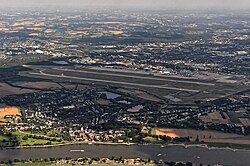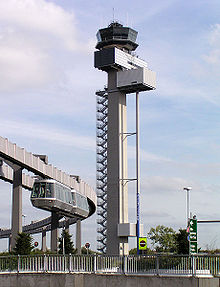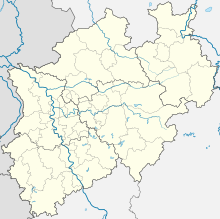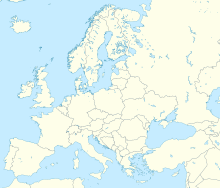Düsseldorf Airport (IATA: DUS, ICAO: EDDL) (German: Flughafen Düsseldorf, pronounced [ˌfluːkhaːfn̩ ˈdʏsl̩dɔʁf]), known as Düsseldorf International Airport until March 2013, is an international airport serving Düsseldorf, the capital of the German state of North Rhine-Westphalia. It is about 7 kilometres (4.3 mi; 3.8 nmi) north of downtown Düsseldorf and some 20 kilometres (12 mi; 11 nmi) southwest of Essen in the Rhine-Ruhr area, Germany's largest metropolitan area.
Düsseldorf Airport Flughafen Düsseldorf | |||||||||||||||
|---|---|---|---|---|---|---|---|---|---|---|---|---|---|---|---|
 | |||||||||||||||
| Summary | |||||||||||||||
| Airport type | Public | ||||||||||||||
| Owner/Operator | Flughafen Düsseldorf GmbH | ||||||||||||||
| Serves | Rhine-Ruhr | ||||||||||||||
| Location | Düsseldorf-Lohausen, North Rhine-Westphalia | ||||||||||||||
| Opened | 19 April 1927 | ||||||||||||||
| Operating base for | |||||||||||||||
| Elevation AMSL | 44.8 m / 147 ft | ||||||||||||||
| Coordinates | 51°17′22″N 6°46′00″E / 51.28944°N 6.76667°E | ||||||||||||||
| Website | www | ||||||||||||||
| Map | |||||||||||||||
| Runways | |||||||||||||||
| |||||||||||||||
| Statistics (2022) | |||||||||||||||
| |||||||||||||||
Düsseldorf is the fourth-busiest airport in Germany and handled almost 8 million passengers in 2021.[3] It is a hub for Eurowings and a focus city for several more airlines. The airport has three passenger terminals and two runways and can handle wide-body aircraft up to the Airbus A380.[4]
Overview
editUsage
editDüsseldorf Airport is the largest and primary airport for the Rhine-Ruhr metropolitan region – the largest metropolitan region in Germany and among the largest metropolitan areas in the world.[5] The airport is located in Düsseldorf-Lohausen. The largest nearby business centres are Düsseldorf and Essen; other cities within a 20-kilometre (12 mi) radius are Duisburg, Krefeld, Mülheim an der Ruhr, Neuss, and Wuppertal. The airport extends over a compact 6.13 square kilometres (2.37 sq mi) of land – small in comparison to airports of a similar capacity, but also a reason for Düsseldorf being known as an airport of short distances.[clarification needed] The airport has more than 18,200 employees.
With around 16 million passengers passing through in 2022,[6] the airport was the fourth busiest in Germany, after Frankfurt Airport, Munich Airport and Berlin Brandenburg Airport. It was the 31st-busiest airport in Europe in 2022.
Ownership
editThe city of Düsseldorf owns half the airport, with the other half owned by various commercial entities. Düsseldorf Airport is a public–private partnership with the following owners:
- 50% city of Düsseldorf
- 50% Airport Partners GmbH (owners: 40% AviAlliance GmbH, 40% Aer Rianta International cpt, 20% AviC GmbH & Co. KGaA)
History
editEarly years
edit
The current airport was opened on 19 April 1927, after two years of construction. The first international route was inaugurated by SABENA in 1929 between Brussels, Antwerp, Düsseldorf and Hamburg.[7]
At the beginning of World War II, civil use of the airport ceased in September 1939 and the airfield was used by the military.[7] After the end of the war, the airport reopened for civil use in 1948. With the area under British administration, the first international flights were operated by British European Airways to London.[7]
Since 1950, the airport is owned by a state-owned operations company.[7]
On 1 April 1955, Lufthansa started services between Düsseldorf, Frankfurt am Main, and Munich,[7] which still exist today. In 1959, the first scheduled jet aircraft landed in Düsseldorf on Scandinavian Airlines' Copenhagen-Khartoum route.[7] In 1961, LTU relocated its home base from Cologne Bonn Airport and in the same year, Düsseldorf Airport handled more than one million passengers for the first time.[7]
In 1969 the main runway was lengthened to 3000 metres while a new second terminal was under construction.[7] The new Terminal 2, which is today's Terminal B, opened in April 1973.[7] Another addition, today's Terminal A, was opened in 1977[7] while the last annex, Terminal C, opened in 1986.[7]
Düsseldorf Airport fire
edit
On 11 April 1996, the Düsseldorf Airport fire, which is the worst structural airport fire worldwide to date, broke out. It was caused by welding work on an elevated road in front of Terminal A above its arrivals area. Insufficient structural fire protection allowed the fire and especially the smoke to spread fast, destroying large parts of the passenger areas of the airport. Seventeen people died, mostly due to smoke inhalation, with many more hospitalised. At the time, the fire was the biggest public disaster in the history of North Rhine-Westphalia. Damage to the airport was estimated to be in the hundreds of millions; Terminals A and B had to be completely reconstructed. While repairs were ongoing, passengers were housed in big tents.[8]
In November 1997, Terminal C was completely redeveloped, with three lightweight construction halls serving as departure areas. Also in 1997 construction began on the new inter-city railway station at the eastern edge of the airport. In 1998 the rebuilt Terminal A was reopened and the airport changed its name from "Rhine Ruhr Airport" to "Düsseldorf International". Reconstruction of the central building and Terminal B began in the same year.[9]
Development since the 2000s
edit
The first construction stage in the "Airport 2000+" programme commenced in 1998 with the laying of a foundation stone for an underground parking garage under the new terminal.[10]
The new Düsseldorf Airport station was opened in May 2000, with a capacity of 300 train departures daily. 16 million passengers used the airport that year; Düsseldorf is now the third-biggest airport in Germany. The new departures hall and Terminal B were opened in July 2001 after 2½ years of construction time; the rebuilt Gebäude Ost (East Building) was reopened.
In 2002, the inter-terminal shuttle bus service was replaced by the suspended monorail called the SkyTrain connecting the terminal building with the InterCity train station. The monorail travels the 2.5 kilometres (1.6 mi) between the terminal and station at a maximum speed of 50 kilometres per hour (31 mph). The system was developed by Siemens and is based on the similar H-Bahn operating with two lines on the Dortmund university campus.
On 12 November 2006, the first Airbus A380 landed in Düsseldorf as part of a Lufthansa promotional flight.
In March 2013, the Airport received a new corporate design and dropped the phrase International from its official name.[11]
In January 2015, Emirates announced it would schedule the Airbus A380 on one of their two daily flights from Dubai to Düsseldorf starting in July 2015.[12] In May 2015, the airport finished construction of the new facilities needed to handle the A380, including a parking position with three jet-bridges, widened taxiways and new ground handling equipment.[4]
In June 2015, Lufthansa announced the closure of its long-haul base at Düsseldorf Airport for economic reasons by October 2015. The base consisted of two Airbus A340-300s which served Newark and Chicago-O'Hare. Newark remained a year-round service which is operated in a W-pattern from Munich Airport (Munich - Newark - Düsseldorf - Newark - Munich) while the Chicago service was suspended for the winter 2015/2016 season.[13] A few months later, Lufthansa announced the cancellation of the Düsseldorf-Chicago route.[14] The same route was served by American Airlines during the summer seasons from 2013[15] to 2016, when it was discontinued.[16]
In January 2017, the airport's largest hub operator Air Berlin announced a massive downsizing of its operations due to restructuring measures. While some leisure routes were handed to Niki more than a dozen destinations were cancelled entirely.[17] In August 2017, Air Berlin also announced the termination of all long-haul routes from Düsseldorf to destinations in the Caribbean on short notice due to ongoing bankruptcy proceedings.[18] However, both Condor and Eurowings announced it would step in and start some of the terminated Caribbean destinations by themselves.[19][20] Shortly after, Air Berlin also announced the termination of all remaining long-haul operations leading to the loss of several connections to the United States at Düsseldorf Airport.[21] On 9 October 2017, Air Berlin announced the termination of all of its own operations, excluding wetleases, by the end of the month[22][23] leading to the loss of one of the airport's largest customers.
In February 2018, Eurowings announced the relocation of all long-haul routes currently served from Cologne Bonn Airport to Düsseldorf by late October 2018 to strengthen its presence there.[24]
In March 2018, Lufthansa announced it would close its base at Düsseldorf Airport after the 2018/2019 winter schedule which ended in March 2019. When the single remaining long-haul route to Newark was taken over by Eurowings, 400 staff members were offered a relocation to either Frankfurt Airport or Munich Airport.[25][26] In November 2018, Ryanair also announced they would close their base in Düsseldorf after only a year. Its routes were taken over by Lauda.[27]
In August 2020, Delta Air Lines removed the Atlanta route from their schedule due to the COVID-19 pandemic.[28] It started resuming its three-times-weekly service to and from Atlanta on May 9, 2023, albeit making the route to Düsseldorf summer seasonal only, therefore leaving the airport without any transatlantic connection in the winter season.[29]
Shortly after Delta Air Lines suspended its Atlanta route, Ryanair announced the closure of its base in Düsseldorf - which was operated on a wetlease basis by Lauda - by 24 October 2020.[30] In September 2020, Singapore Airlines permanently removed the route to Singapore from their schedule.[31]
In the autumn of 2022, German airline Sundair drastically reduced its operations from Düsseldorf, leaving a single route to Beirut. The two previously based aircraft were relocated. In January 2023 it became public that Sundair would not return to Düsseldorf in the summer season of 2023 with any flight, eradicating its former base from the network.[32][33]
Just five months after resuming the previously long-standing route to Atlanta, Delta Air Lines announced in September 2023 that it would not return to Düsseldorf in the 2024 summer season. The route had been announced at only three weekly flights and was downgraded to summer seasonal before it even started.[34] This leaves Düsseldorf without a single scheduled transatlantic flight.[citation needed]
Facilities
edit



Terminals
editDüsseldorf Airport has three terminals connected by a central spine, even though the terminals are essentially concourses within a single terminal building. The current terminal buildings are capable of handling up to 22 million passengers per year.
Terminal A
editTerminal A was opened in 1977 and has 16 gates (A01–A16) used by Lufthansa and Eurowings, its airline partners and Star Alliance members, Austrian Airlines, Croatia Airlines, LOT Polish Airlines, Scandinavian Airlines, TAP Air Portugal, and Swiss International Air Lines. Terminal A houses two Lufthansa lounges. It was refurbished fundamentally for two years after the 1996 fire.
Terminal B
editTerminal B was originally inaugurated in 1973 and has 11 gates (B01–B11) used for domestic and EU flights by a few Star Alliance members such as Aegean Airlines, but mainly by SkyTeam and Oneworld members like Air France, British Airways, KLM, Finnair, Iberia and ITA Airways. Also located within this terminal are leisure carriers such as TUIfly and Condor. Terminal B houses an observation deck, which got shutdown after the COVID-19 outbreak due to economic reasons,[35] and one contract lounge [36] After the fire in 1996, the whole terminal building was torn down and reconstructed. It was reopened in 2001.
Terminal C
editTerminal C was opened in 1986 and has 8 gates (C01–C08) used exclusively for non-Schengen flights by non-Star Alliance airlines (except Turkish Airlines). These are long-haul flights – among others – by Emirates and Etihad Airways. Terminal C has a direct access to Airport City's Maritim Hotel, part of a German hotel chain, and houses lounges operated by the airport and Emirates. Terminal C was the least affected terminal after the fire in 1996, reopening the same year after intensive maintenance work. Thus it was the only usable Terminal at Düsseldorf Airport for a couple of years. Terminal C features the airport's only parking position equipped with three jet-bridges to handle the Airbus A380.[12]
Executive Terminal
editJet Aviation operates a small terminal solely for private and corporate customers.
Runways and apron
editDüsseldorf has two runways, which are 3,000 metres (9,843 ft) and 2,700 metres (8,858 ft) long. There are plans to extend the 3,000-metre (9,843 ft) runway to 3,600 metres (11,811 ft), but the town of Ratingen has been blocking the expansion, as it lies within the approach path of the runway. 107 aircraft parking positions are available on the aprons.
Airport City
editSince 2003, an area of 23 hectares (57 acres) southwest of the airport terminal has been under redevelopment as Düsseldorf Airport City with an anticipated gross floor area of 250,000 square metres (2,700,000 sq ft) to be completed by 2016. Already based at Düsseldorf Airport City are corporate offices of Siemens and VDI, a large Porsche centre and showroom, a Maritim Hotel,[37] and a Sheraton Hotel. Messe Düsseldorf is situated in close proximity to Düsseldorf Airport City (some 500 m or 1,600 ft).
Airlines and destinations
editPassenger
editThe following airlines offer regular scheduled and charter flights at Düsseldorf Airport:
Cargo
edit| Airlines | Destinations |
|---|---|
| FedEx Express[90] | Paris–Charles de Gaulle |
Statistics
editPassengers and freight
editGraphs are unavailable due to technical issues. There is more info on Phabricator and on MediaWiki.org. |
| Passengers | Movements | Freight (in t) | |||||
|---|---|---|---|---|---|---|---|
| 2000 | 16.03 million | 194,016 | 59,361 | ||||
| 2001 |  15.40 million 15.40 million |  193,514 193,514 |  51,441 51,441 | ||||
| 2002 |  14.75 million 14.75 million |  190,300 190,300 |  46,085 46,085 | ||||
| 2003 |  14.30 million 14.30 million |  186,159 186,159 |  48,419 48,419 | ||||
| 2004 |  15.26 million 15.26 million |  200,584 200,584 |  86,267 86,267 | ||||
| 2005 |  15.51 million 15.51 million |  200,619 200,619 |  88,058 88,058 | ||||
| 2006 |  16.59 million 16.59 million |  215,481 215,481 |  97,000 97,000 | ||||
| 2007 |  17.83 million 17.83 million |  227,899 227,899 |  89,281 89,281 | ||||
| 2008 |  18.15 million 18.15 million |  228,531 228,531 |  90,100 90,100 | ||||
| 2009 |  17.79 million 17.79 million |  214,024 214,024 |  76,916 76,916 | ||||
| 2010 |  18.98 million 18.98 million |  215,540 215,540 |  87,995 87,995 | ||||
| 2011 |  20.39 million 20.39 million |  221,668 221,668 |  81,521 81,521 | ||||
| 2012 |  20.80 million 20.80 million |  210,298 210,298 |  86,820 86,820 | ||||
| 2013 |  21.23 million 21.23 million |  210,828 210,828 |  110,814 110,814 | ||||
| 2014 |  21.85 million 21.85 million |  210,732 210,732 |  114,180 114,180 | ||||
| 2015 |  22.48 million 22.48 million |  210,208 210,208 |  90,862 90,862 | ||||
| 2016 |  23.52 million 23.52 million |  217,575 217,575 |  93,689 93,689 | ||||
| 2017 |  24.62 million 24.62 million |  221,635 221,635 |  102,107 102,107 | ||||
| 2018 |  24.28 million 24.28 million |  218,820 218,820 |  75,030 75,030 | ||||
| 2019 |  25.51 million 25.51 million |  225,935 225,935 | |||||
| 2020 |  6.6 million 6.6 million |  78,805 78,805 | |||||
| 2021 |  7.95 million 7.95 million |  82,189 82,189 | |||||
| 2022 |  16.07 million 16.07 million |  140,598 140,598 | Source: ADV German Airports Association[91] | ||||
| 2023 |  19.12 million 19.12 million |  146,626 146,626 | Source: ADV German Airports Association[92] | ||||
Busiest routes
edit| Rank | Destination | Passengers handled |
|---|---|---|
| 1 | Palma de Mallorca | 1,495,562 |
| 2 | Munich | 1,419,069 |
| 3 | Berlin | 1,197,615 |
| 4 | Istanbul | 1,068,462 |
| 5 | London | 895,346 |
| 6 | Antalya | 848,617 |
| 7 | Vienna | 735,520 |
| 8 | Zürich | 732,520 |
| 9 | Dubai | 532,407 |
| 10 | Hamburg | 525,614 |
Source: Düsseldorf Airport[93]
Largest airlines
edit| Rank | Airline | Passengers handled |
|---|---|---|
| 1 | Eurowings/Germanwings | 8.3m |
| 2 | Lufthansa | 1.7m |
| 3 | Condor | 1.6m |
| 4 | TUI fly Deutschland | 992,000 |
| 5 | SunExpress | 728,000 |
Ground transportation
edit

Train
editDüsseldorf Airport has two railway stations:
- The S-Bahn station, Düsseldorf Airport Terminal station, is located below the terminal. It is served by the S11 suburban line, which has its northern terminus there.
- The main station, Düsseldorf Airport station, is located 2.5 km (1.6 mi) from the terminal, and is served by all categories of railway, including Intercity Express (ICE) high-speed trains. A fully automatic suspended monorail called SkyTrain connects this station to the airport parking areas and the passenger terminals and also serves as an inter-terminal connection.
Road
editThe airport can be reached via its own motorway section which is part of the motorway A44 (Belgium – Kassel, Exit Düsseldorf-Flughafen) which also connects to motorways A52, A57 and A3. There are also several local bus lines connecting the airport with nearby areas and Düsseldorf city center.[95]
Other facilities
edit- Düsseldorf Airport had the headquarters of Air Berlin's technical training facilities and also served as one of their maintenance bases.[96]
- When LTU International existed, its head office was in Halle 8 at Düsseldorf Airport.[97]
- The corporate head office of Blue Wings was also located in Terminal A at the airport.[98][99]
Flight restrictions
editThe authorities do not allow flights to or from this airport between 23:00 and 6:00.[citation needed]
Incidents and accidents
edit- On 22 December 1955, a Manx Airlines Douglas C-47 on a positioning flight crashed at DUS attempting a visual approach rather than an instrument landing system approach in low clouds. The aircraft descended too low and struck trees, crashing about three miles from the runway. All three occupants were killed.[100]
- On 3 November 1957, a Karl Herfurtner Düsseldorf Douglas C-54 crashed into a residential area 4.5 km (2.8 mi) S of DUS after takeoff due to mismanagement of the flight by the chief pilot. There were six fatalities out of the 10 on board and one killed on the ground.[101]
See also
edit- Transport in Germany
- Weeze Airport, an airport 80 km (50 mi) north-west from Düsseldorf, that is sometimes advertised by low-cost airlines as "Düsseldorf-Weeze" or "Weeze (Düsseldorf)". A German court ruled that naming the airport after Düsseldorf would be misleading to passengers; however, some airlines still use that name in advertisements outside Germany.
References
editExternal links
edit Media related to Düsseldorf Airport at Wikimedia Commons
Media related to Düsseldorf Airport at Wikimedia Commons
- Official website Archived 6 November 2014 at the Wayback Machine
- Current weather for EDDL at NOAA/NWS
- Accident history for DUS at Aviation Safety Network





